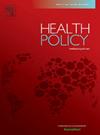The challenge of access to healthcare services as a condition for territorial equity. A methodological approach for sparsely populated rural areas
IF 3.4
3区 医学
Q1 HEALTH CARE SCIENCES & SERVICES
引用次数: 0
Abstract
Access to basic healthcare services poses a significant challenge for sparsely populated rural areas within the European Union, impacting fundamental principles such as territorial equity. This challenge is intensified by current demographic trends, including depopulation and ageing, which affect both the availability of healthcare professionals and the increased demand for efficient healthcare services for the older population. To address this issue, the present study adopts a methodological approach that uses distance and transport time to measure the accessibility of different rural municipalities to healthcare facilities. This study focuses on the Autonomous Region of Castilla-La Mancha (Spain) as a representative territory for the abovementioned demographic dynamics. The main results indicate a clear relationship between negative demographic indicators and poorer healthcare access, especially in rural areas with limited transportation infrastructure. Access to primary healthcare is generally well distributed, with >90 % of rural population living within 15 min of a basic healthcare facility, while hospitals are less accessible for the rural population, with >40 % of the sample needing 30 min to reach one. The sample is also highly sensitive to the population density and ageing rates. As a significant contribution, a universal methodology is presented that can be applied to other rural territories with a significant ageing population, enabling territorial planning policies to optimize quality healthcare in line with the active ageing policies promoted by the United Nations.
将获得保健服务作为领土平等条件的挑战。人口稀少的农村地区的方法方法
获得基本医疗保健服务对欧洲联盟内人口稀少的农村地区构成了重大挑战,影响到领土公平等基本原则。当前的人口趋势,包括人口减少和老龄化,既影响了医疗专业人员的可用性,也增加了老年人对高效医疗服务的需求,从而加剧了这一挑战。为解决这一问题,本研究采用了一种方法论,即利用距离和交通时间来衡量不同农村市镇对医疗设施的可及性。本研究将卡斯蒂利亚-拉曼恰自治区(西班牙)作为上述人口动态的代表地区。主要结果表明,负面人口指标与较差的医疗服务之间存在明显的关系,尤其是在交通基础设施有限的农村地区。获得初级医疗服务的机会总体上分布合理,90% 的农村人口居住在距离基本医疗设施 15 分钟以内的地方,而农村人口较难到达医院,40% 的样本需要 30 分钟才能到达医院。样本对人口密度和老龄化率也非常敏感。作为一项重大贡献,该研究提出了一种通用方法,可应用于人口老龄化严重的其他农村地区,从而使地区规划政策能够根据联合国提倡的积极老龄化政策优化医疗质量。
本文章由计算机程序翻译,如有差异,请以英文原文为准。
求助全文
约1分钟内获得全文
求助全文
来源期刊

Health Policy
医学-卫生保健
CiteScore
6.40
自引率
6.10%
发文量
157
审稿时长
3-8 weeks
期刊介绍:
Health Policy is intended to be a vehicle for the exploration and discussion of health policy and health system issues and is aimed in particular at enhancing communication between health policy and system researchers, legislators, decision-makers and professionals concerned with developing, implementing, and analysing health policy, health systems and health care reforms, primarily in high-income countries outside the U.S.A.
 求助内容:
求助内容: 应助结果提醒方式:
应助结果提醒方式:


